Photons & Fusion Newsletter
August 2012
Photons & Fusion is a monthly review of science and technology at the National Ignition Facility & Photon Science Directorate. For more information , submit a question.
Preparing the NIF Beamlines for Routine High-Energy Operations
Much more went into NIF's record-breaking two-megajoule (MJ), 500-terawatt (TW)-plus shot on July 5 than just turning up the energy of NIF's 192 powerful lasers (see the LLNL News Release). In order for NIF to reach the performance goals set for it in the late 1990s, practically every aspect of the complex laser system had to be analyzed, evaluated, upgraded, realigned, and fine-tuned as never before.
"This was an outstanding effort by all the NIF engineering and science teams," said Laser Commissioning Manager Scott Burkhart. "The result was a major upgrade to the facility, and NIF is now operating routinely at the energy levels for which NIF was designed."
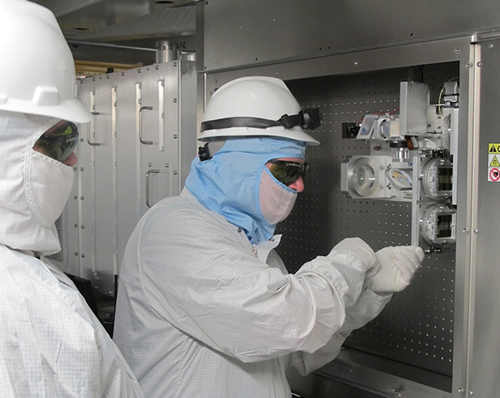 Injection Laser System operators Bill Bybee (left) and Brian Franklin inspect the new mask in a preamplifier module before starting alignment tests. The masks determine the initial size and shape of the NIF laser beams.
Injection Laser System operators Bill Bybee (left) and Brian Franklin inspect the new mask in a preamplifier module before starting alignment tests. The masks determine the initial size and shape of the NIF laser beams. The work of NIF's laser scientists to measure and minimize amplitude modulation (AM), or rapid variations in laser beam peak power as a function of time (see July Photons & Fusion), was just part of the story. At lower energy levels, the NIF laser beams were small enough to comfortably fit inside the meter-sized optical amplifiers that boost their energy from a few billionths of a joule to several megajoules. Increasing the dimensions of the beams, however, meant they had to be precisely rotated and positioned so they wouldn't touch the edges of the optics and lose energy, and possibly damage the optics.
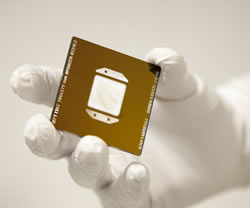 The "apodizer mask" enables the beam to propagate over a long distance with minimal "ringing" at the edges of the beam from diffraction.
The "apodizer mask" enables the beam to propagate over a long distance with minimal "ringing" at the edges of the beam from diffraction. "Achieving full energy and power meant making maximum use of the (optics) apertures," Burkhart said. "Being conservative, as we had been up to now, meant there was 5 to 10 percent more beamline area available for the beams."
Early this year the NIF team began an experimental program to determine how much larger the beams could be made while still ensuring safe propagation through the laser chain. Different masks (filters in the preamplifier modules, or PAMs, that tailor the beams to the desired size and shape) were designed and tested, and the beam size was increased in small increments until the optimum size was reached.
Additional beam area was gained by optimizing the number and position of the "corner blockers" installed in one or more corners of each beam aperture to block "counter-propagating" light returning through the beamlines from the target chamber.
Beam clipping even at very low intensity levels at the beam edge causes light to radiate back into the main beam, causing interference fringes or intensity ripples. Above a certain point the result could be damaging to the optics, and even to the metal brackets holding the optics in place. NIF engineering and technician teams fine-tuned the beam size for each of the 192 beams, optimizing beam size to the available aperture.
NIF's unique square beams also posed a challenge. "Optimizing the rotation of the beams was pretty tricky," Burkhart said. "It was a time-consuming process to rotate each beam by a small amount to ensure the larger beams fit within the apertures without clipping at the corners." Each rotation produced a flood of data that had to be analyzed by a special team assembled for the purpose.
 A NIF technician installs a corner blocker on an optics line replaceable unit to protect the optics from potentially damaging stray laser light. The blockers are made of the same plastic used in ski goggles.
A NIF technician installs a corner blocker on an optics line replaceable unit to protect the optics from potentially damaging stray laser light. The blockers are made of the same plastic used in ski goggles. Finally, the team used NIF's powerful Final Optics Damage Inspection System, or FODI, to image the beamlines from the center of the Target Chamber and verify that the apertures were the correct size and the beams were properly centered in the final optics. The FODI produced more huge data files that had to be painstakingly analyzed.
The result of all these adjustments, Burkhart said, was "beams that are both bigger and more spatially uniform. By doing this we were able to bring the peak laser intensity down so that the intensity doesn't exceed the damage threshold of the optics."
"This was the first time such a level of tuning has been done at NIF in a unified way," added Scientific Lead Sham Dixit. "All areas of NIF Operations – transport and handling, target fabrication, the ARC (Advanced Radiographic Capability) team – everybody was drafted to accomplish this major modification to the laser."
White House Science Advisor Tours NIF
John Holdren, Assistant to the President for Science and Technology, Director of the White House Office of Science and Technology Policy, and Co-Chair of the President's Council of Advisors on Science and Technology (PCAST), along with U.S. Rep. Zoe Lofgren, a member of the House Committee on Science, Space, and Technology, toured NIF on Aug. 7 and received a briefing on the National Ignition Campaign.
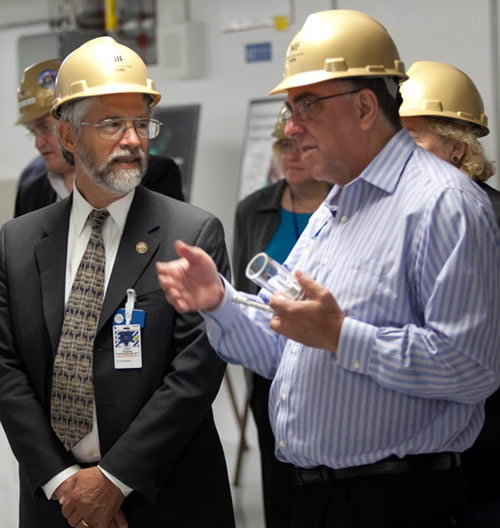 NIF Director Ed Moses, right, briefs White House Science Advisor John Holdren during his Aug. 7 tour of NIF.
NIF Director Ed Moses, right, briefs White House Science Advisor John Holdren during his Aug. 7 tour of NIF. During an all-hands presentation to Livermore and Sandia National Laboratories employees, Holdren compared NIF to the recently-landed Mars rover Curiosity, calling them examples of "enormously complicated, advanced and sophisticated technology coming together in a system of absolutely daunting complexity.
"Looking at (NIF), you could hardly believe that it would work," he said. "But it does work. The NIF works. And it's getting close to ignition. And I'm among the many folks who wish it well."
Lab Director Congratulates NIF Team for Reaching Laser Performance Goals
In an informal ceremony on Aug. 6, LLNL Director Parney Albright praised the members of the NIF team for their "absolutely tremendous...incredible achievement" in firing the world's first 2-MJ, 500-TW laser shots.
Speaking to nearly 1,000 NIF&PS workers, the Director said NIF's ability to reach the two major milestones "would not have occurred without everybody here. Every time I've come through (NIF) and every single person I have met has just blown me away with how superbly competent they are and the level of enthusiasm that they bring to the job. And without that, how could you possibly have achieved what you've achieved?"
Noting the challenges involved in doing groundbreaking science "on demand" or by a certain date, the Director said there is "broad recognition" in the scientific community that NIF is "exactly the facility we need that will eventually get us to ignition. We haven't gotten there yet, but we are on the way, and every test that you do and every ignition shot that you do illuminates the physics and the science of the problem in a way that moves us just another step closer.
"You should revel in your achievement," he concluded, "and you should revel in the fact that we are making progress forward. And you should revel also in the fact that as you look around at your colleagues...that you are really working with the very, very, very best. Where else on the planet could you do that?"
NIF Optics Team Reaches Two Production Milestones
Quickly refurbishing and replacing optical components in the NIF beamlines is a key factor in NIF's ability to routinely operate at high levels of energy and power. At the end of August the NIF optics team passed two production milestones: the Optics Production Facility (OPF) and Optics Mitigation Facility (OMF) in Bldg. 391 have now completed damage mitigation of 1,000 wedged focus lenses (WFLs), while the optics fabrication team completed fabrication of 10,000 disposable debris shields (DDS's).
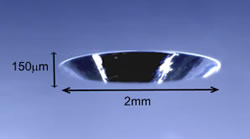 Damaged sites repaired in the Optics Mitigation Facility range in size from 0.36 to 2.0 millimeters.
Damaged sites repaired in the Optics Mitigation Facility range in size from 0.36 to 2.0 millimeters. WFLs are wedged-shaped lenses in the NIF final optics assemblies that focus and direct the beamlines to the center of the NIF Target Chamber. Tiny (sub-micron) flaws can grow and damage the lenses when they are subjected to the intense ultraviolet light from the NIF lasers. When sites are identified by the Final Optics Damage Inspection System, the lenses are removed from NIF and cleaned, recoated and inspected in the OPF. The damage sites are then mitigated in the OMF with a focused carbon-dioxide laser that micromachines away the damaged material, leaving a benign cone-shaped pit. The WFLs are then returned to service.
The DDS's, the components closest to the Target Chamber in the final optics assemblies, protect the main debris shields, WFLs, and other optics from target debris during NIF shots. Delivery of the 10,000th 3.3-millimeter-thick DDS is a culmination of closely coordinated efforts between the optics team and NIF vendors that began in late 2009.
High-quality materials and advanced finishing techniques were developed to produce DDS's that meet NIF's requirements. DDS deliveries were gradually ramped up from about 150 a month to the current rate of 667 a month, or 8,000 a year.
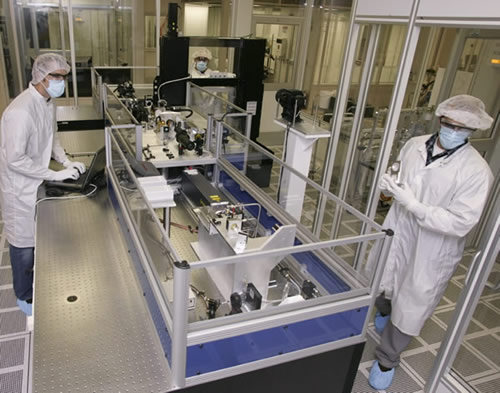 Technicians operate a mitigation station in the Optics Mitigation Facility. The facility repairs laser damage on about 40 wedged focus lenses and grating debris shields a week.
Technicians operate a mitigation station in the Optics Mitigation Facility. The facility repairs laser damage on about 40 wedged focus lenses and grating debris shields a week. HED Plasma Research on NIF Receives 'UC Fee' Grant
The high energy density (HED) plasmas formed in NIF experiments not only trigger fusion reactions but can also excite nuclear states through atomic-nuclear interactions. This capability opens a new field of scientific inquiry to understand how nuclei are formed in HED plasmas, such as the cores of stars and inside nuclear weapons.
 Darren Bleuel and Andrea Kritcher with posters describing their research.
Darren Bleuel and Andrea Kritcher with posters describing their research. The importance of this research area has been recognized with the approval of a UC Laboratory Fees Research Grant proposal titled "Nuclear Reactions in High Energy Density Plasmas at NIF." LLNL scientists Darren Bleuel and Andrea Kritcher, together with UC Berkeley Professor of nuclear engineering Karl Van Bibber, director of the university's Nuclear Science and Security Consortium, are the principal investigators for this effort. The research will involve experiments at NIF, the Laboratory for Laser Energetics at the University of Rochester, and the GSI heavy ion research laboratory in Darmstadt, Germany.
The "UC Fee" grants are funded from the fees that the University receives for the management of Los Alamos and Livermore national laboratories based on an annual performance evaluation.
Researchers Study Radiation Tolerance of NIF Target 'Tents'
In NIF targets, the fuel capsule is suspended in the center of the target by two ultra-thin polymer films known as "tents." They center the capsule by pushing against it from the top and the bottom like springs.
Only 500 to 1,000 atoms thick, the films are highly sensitive to environmental effects. A recent study by LLNL researchers published online on Aug. 16 in Applied Physics Letters examined the mechanical properties of these ultra-thin films after irradiation and determined how their elastic modulus (stiffness) and failure strain (breaking point) degraded with electron exposure. The results guided the development of the current fill and transport procedures for NIF targets that contain tritium.
Lead author Michael Stadermann was joined on the paper by Sergei Kucheyev, James Lewicki, and Steve Letts.
A New Theory of How the Earth and Moon Were Born
A "new paradigm" describing how the moon was formed from a high-velocity giant impact between an object less than the mass of Mars and a rapidly spinning "proto-Earth" was described by Harvard University planetary scientist Sarah Stewart at a NIF High Energy Density Science Seminar Aug. 23.
Since the 1970s, scientists have theorized that after a series of collisions between planetary "embryos" created the Earth, a final giant impact melted the young planet and threw off massive chunks that gradually coalesced to form the moon. The details of that theory, however, have been called into question by recent geochemical studies of the Earth and moon indicating anomalies in their chemical composition and challenging the notion that the early Earth was completely molten.
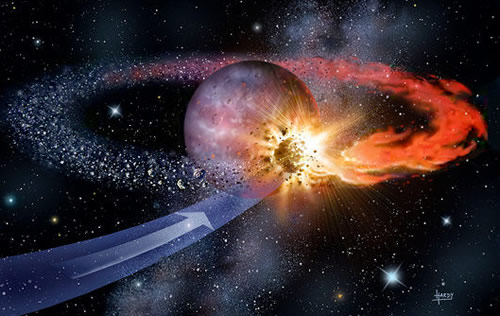 Artist's conception of the formation of the Moon according to the giant impact theory. Credit: David A. Hardy/Science Photo Library
Artist's conception of the formation of the Moon according to the giant impact theory. Credit: David A. Hardy/Science Photo Library Stewart said equation-of-state experiments at high-energy-density facilities like NIF are needed to study the thermodynamics of giant impacts. Such experimental data, along with new modeling codes, could test the emerging theories about the state of the early Earth, and the mechanisms that produced the lunar disk, against the new geochemical data.
Dunne Describes NIC Progress at 'Big Physics' and TOFE Conferences
NIF&PS Director for Laser Fusion Energy Mike Dunne presented a keynote address titled, “The Path to Exploring the Cosmos and Laser Fusion Energy,” at the sixth annual Science and Big Physics Summit on Aug. 7. The meeting, sponsored by National Instruments (NI), was held in conjunction with NIWeek.
The Science and Big Physics summit is a technical workshop that brings together scientists and engineers from major national and research labs to discuss topics in the areas of control, measurement and diagnostics for particle accelerators, synchrotrons, fusion reactors and telescopes.
Dunne also gave a plenary talk titled, “Progress in NIF Toward Ignition,” on Aug. 30 at the American Nuclear Society (ANS) 20th Topical Meeting on the Technology of Fusion Energy (TOFE 2012). Other researchers presenting at the conference included LLNL’s Susana Reyes and Al Erlandson, and Kurt Boehm of General Atomics.
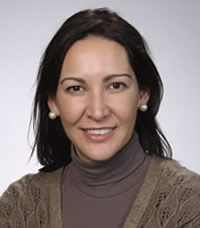 Susana Reyes
Susana ReyesSusana Reyes Receives ANS Professional
Women's Achievement Award
LLNL nuclear engineer Susana Reyes is the 2012 recipient of the ANS Mary Jane Oestmann Professional Women’s Achievement Award. Susana serves as vice-chair of the ANS Fusion Energy Division. The award recognizes her “leadership in developing detailed hazard and safety analyses for both inertial and magnetic fusion facilities, including NIF and ITER, and future power reactors.”
The award is given annually for outstanding personal dedication and technical achievement by a woman in the fields of nuclear science, engineering, research or education. The award will be presented at the ANS Winter Meeting in November.
Lasers Provide Insights Into Formation of Galactic Magnetic Fields
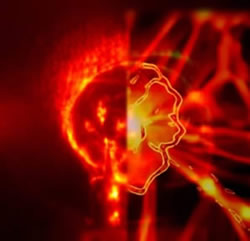 Left: an image of a laser-produced shock wave; brighter colors correspond to regions of higher density or temperature (i.e. a shock). Right: Simulation of a collapsing shock wave arising in a protogalaxy. (Credit: LULI /Swiss Federal Institute of Technology)
Left: an image of a laser-produced shock wave; brighter colors correspond to regions of higher density or temperature (i.e. a shock). Right: Simulation of a collapsing shock wave arising in a protogalaxy. (Credit: LULI /Swiss Federal Institute of Technology) The use of high-power lasers to study the mysterious origins of huge magnetic fields that span the galaxies was described by Gianluca Gregori of the University of Oxford at an Aug. 9 High Energy Density Science Seminar. Gregori said recent experiments at the Laboratory for the Use of Intense Lasers (LULI) near Paris have confirmed that the magnetic fields could have been “seeded” by misaligned temperature and pressure gradients during galaxy formation.
To test the theory, the researchers trained intense, short-duration laser pulses on a carbon rod held inside a helium-filled chamber to create shock waves. As the shock wave moved through the plasma in the chamber, a magnetic field was generated. The results are consistent with the simulations.
While the initial seed fields are miniscule, the simulations show that they could be amplified to galactic size over about 700 million years through a "dynamo" mechanism, in which the rotation and turbulence of the galaxy's interstellar medium – the gas and dust between stars – reinforces the original magnetic field.
"We need further studies to explain the large-scale magnetization of the universe," Gregori said. "Only at NIF can we achieve the (magnetic energy) regimes" required to test the theory, he said.
LLNL Researchers Participate in SPIE Optics & Photonics Conference
A number of LLNL researchers participated as organizers, session chairs and presenters in the SPIE Optics & Photonics Conference from Aug. 12 to16.
LLNL’s Lynn Seppala, the invited speaker for the Lens Design Technical Event, discussed examples from his work, starting with multi-relay systems similar to periscopes and finishing with examples from the design of the Large Synoptic Survey Telescope (LSST). Among other talks by LLNL researchers was an invited paper on target and diagnostic alignment at NIF by Daniel Kalantar.
The conference featured the release of a new National Research Council report, Optics and Photonics: Essential Technologies for our Nation, which states that optics and photonics provide critical enabling technologies across the U.S. and world economies.
NIF Diagnostics Described at American Chemical Society Meeting
LLNL researchers gave presentations about NIF’s diagnostic equipment in a symposium organized by Dawn Shaughnessy at the American Chemical Society’s Meeting on Materials for Health and Medicine Aug. 19 to 23.

Carol Velsco and LLNL colleagues described the Radiochemical Analysis of Gaseous Samples (RAGS) apparatus for NIF nuclear diagnostics, which collects gases produced during ignition to determine NIF target capsule areal density and ablator-fuel mix. Elements added to the innermost layers of the capsule undergo nuclear activation and following a shot, the activated gases are pumped out of the Target Chamber and transported to the RAGS apparatus for analysis.
In a related presentation, “Solid debris collection for radiochemical diagnostics at NIF,” Julie Gostic and LLNL colleagues discussed the role of solid debris collection in a variety of experiments at NIF, including capsule diagnostics, stockpile stewardship, and nuclear physics measurements.
In addition, Darren Bleuel and colleagues from LLNL, the University of New Mexico and Sandia National Laboratories described the extensive suite of neutron activation diagnostics used to measure neutron yields at NIF. Neutron yields are routinely measured to an accuracy of 7 percent, the researchers said, and are in excellent agreement both with each other and with neutron time-of-flight and magnetic recoil spectrometer measurements.
NIF Visitors
Heavy Ion Inertial Fusion Researchers Take a Look at NIF
Participants in the19th International Symposium on Heavy Ion Inertial Fusion (HIF2012), held from Aug. 12 to 17 at Lawrence Berkeley National Laboratory, toured NIF on Aug. 15. Heavy ion fusion uses short, intense bursts of heavy ions driven by a particle accelerator to implode an inertial confinement fusion target similar to a NIF target.
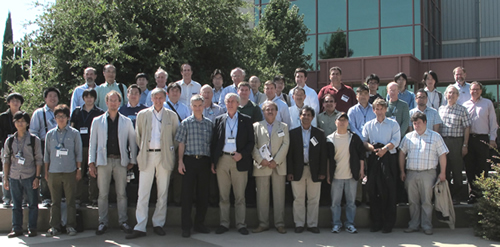 Participants in the19th International Symposium on Heavy Ion Inertial Fusion pose in front of NIF.
Participants in the19th International Symposium on Heavy Ion Inertial Fusion pose in front of NIF. In a thank-you note to NIF tour guides Bob Kauffman, Chris Keane, and Chris Barty, HIF2012 co-chairs John Barnard and Peter Seidl said, “Our whole group seemed to appreciate the enormity of the accomplishment in creating such a magnificent, cutting edge, scientific facility. We are all watching with intense interest at the progress you all are making towards inertial confinement fusion ignition. As heavy ion fusion energy proponents we understand that no form of inertial fusion energy is likely to proceed without ignition on NIF. We are rooting for your success!”
LLNS Governors Tauscher and Pattiz Tour NIF
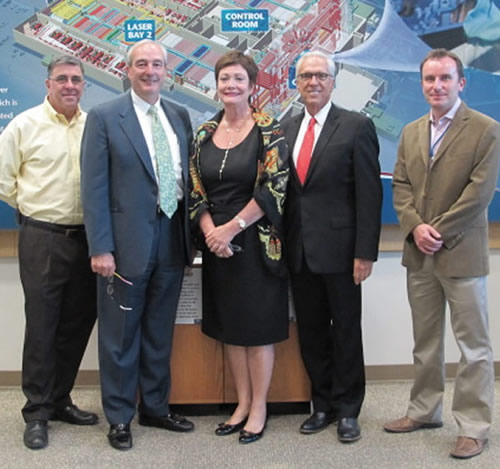 Former U.S. Rep. and Undersecretary of State Ellen Tauscher, Norm Pattiz, chairman of Lawrence Livermore National Security (LLNS) and Los Alamos National Security (LANS) (second from right), and NIF friend Ray Rothrock (second from left) toured NIF on Aug. 21. Ms. Tauscher was recently named an independent governor on the LLNS and LANS boards of governors. The appointments take effect Sept. 17. Ms. Tauscher also has been appointed a member of the LLNS/LANS boards' Mission Committee, which serves in an advisory role to review current and future national security issues and laboratory initiatives, capabilities and strategic plans to address these issues. NIF Director Ed Moses (left) and Mike Dunne (right) led the tour.
Former U.S. Rep. and Undersecretary of State Ellen Tauscher, Norm Pattiz, chairman of Lawrence Livermore National Security (LLNS) and Los Alamos National Security (LANS) (second from right), and NIF friend Ray Rothrock (second from left) toured NIF on Aug. 21. Ms. Tauscher was recently named an independent governor on the LLNS and LANS boards of governors. The appointments take effect Sept. 17. Ms. Tauscher also has been appointed a member of the LLNS/LANS boards' Mission Committee, which serves in an advisory role to review current and future national security issues and laboratory initiatives, capabilities and strategic plans to address these issues. NIF Director Ed Moses (left) and Mike Dunne (right) led the tour. 



